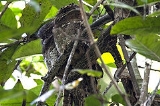
Sri Lanka Frogmouth
Encyclopedia
The Sri Lanka Frogmouth or Ceylon Frogmouth (Batrachostomus moniliger) is a small frogmouth
found in the Western Ghats
of south India and Sri Lanka. Related to the nightjar
s, they are nocturnal and are found in forest habitats. The sexes differ in plumage.
 Like all frogmouths, this 23 centimetres (9.1 in) long species has a wide and hooked bill with slit-like nostrils and the large head has the eyes facing forward to provide binocular vision. Within the genus it has a somewhat small wing and is distinguished by the wing coverts ending in veltety black spots tipped in white. The male is grey brown with fine barring and a spotted crown. Some males are browner and look more similar to females. The female is more rufous or chestnut brown. Indian specimens have black spots on the crown but Sri Lankan populations have no such markings. Formerly considered monotypic, the Western Ghats population have been named as B. m. roonwali. This population has the males with a brownish-gray wing mirror and yellowish spots on the underside (gray or white in the nominate Sri Lankan form). Females have a bright reddish-brown wing mirror and are unspotted below.
Like all frogmouths, this 23 centimetres (9.1 in) long species has a wide and hooked bill with slit-like nostrils and the large head has the eyes facing forward to provide binocular vision. Within the genus it has a somewhat small wing and is distinguished by the wing coverts ending in veltety black spots tipped in white. The male is grey brown with fine barring and a spotted crown. Some males are browner and look more similar to females. The female is more rufous or chestnut brown. Indian specimens have black spots on the crown but Sri Lankan populations have no such markings. Formerly considered monotypic, the Western Ghats population have been named as B. m. roonwali. This population has the males with a brownish-gray wing mirror and yellowish spots on the underside (gray or white in the nominate Sri Lankan form). Females have a bright reddish-brown wing mirror and are unspotted below.
of southwest India
and Sri Lanka
. Its habitat is dense tropical forest usually with dense undergrowth but sometimes found in more disturbed habitats including plantations. Their presence can be overlooked due to their nocturnal behaviour and camouflage.
Frogmouth
The frogmouths are a group of nocturnal birds related to the nightjars. They are found from India across southern Asia to Australia.They are named for their large flattened hooked bills and huge frog-like gape, which they use to capture insects. Their flight is weak.They rest horizontally on...
found in the Western Ghats
Western Ghats
The Western Ghats, Western Ghauts or the Sahyādri is a mountain range along the western side of India. It runs north to south along the western edge of the Deccan Plateau, and separates the plateau from a narrow coastal plain along the Arabian Sea. The Western Ghats block rainfall to the Deccan...
of south India and Sri Lanka. Related to the nightjar
Nightjar
Nightjars are medium-sized nocturnal or crepuscular birds with long wings, short legs and very short bills. They are sometimes referred to as goatsuckers from the mistaken belief that they suck milk from goats . Some New World species are named as nighthawks...
s, they are nocturnal and are found in forest habitats. The sexes differ in plumage.
Description

Habitat and distribution
This species is found in the Western GhatsWestern Ghats
The Western Ghats, Western Ghauts or the Sahyādri is a mountain range along the western side of India. It runs north to south along the western edge of the Deccan Plateau, and separates the plateau from a narrow coastal plain along the Arabian Sea. The Western Ghats block rainfall to the Deccan...
of southwest India
India
India , officially the Republic of India , is a country in South Asia. It is the seventh-largest country by geographical area, the second-most populous country with over 1.2 billion people, and the most populous democracy in the world...
and Sri Lanka
Sri Lanka
Sri Lanka, officially the Democratic Socialist Republic of Sri Lanka is a country off the southern coast of the Indian subcontinent. Known until 1972 as Ceylon , Sri Lanka is an island surrounded by the Indian Ocean, the Gulf of Mannar and the Palk Strait, and lies in the vicinity of India and the...
. Its habitat is dense tropical forest usually with dense undergrowth but sometimes found in more disturbed habitats including plantations. Their presence can be overlooked due to their nocturnal behaviour and camouflage.

